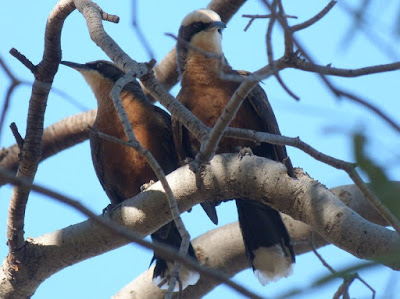A while ago now I started another in my sporadic series on colours in nature, this one on the range of rich red-brown colours which we refer to variously as rufous, copper, chestnut and rusty among others. It was a rewarding lode to mine too, and after three instalments I decided to rest it for a while to look at other aspects of the natural world. I now want to conclude the series with two more offerings on rusty (etc) birds. As you read this I'm helping with bird surveys in the remote Great Sandy Desert of Western Australia, so this is one I prepared earlier, as they say on the cooking shows.
 |
| Radjah Shelduck Tadorna radjah, south of Darwin. This gorgeous tropical shelduck of northern Australia, New Guinea and some nearby islands I think well illustrates why I'm so fond of these shades. |
In that first posting I limited myself to birds with Chestnut or Rufous in their name, and there were plenty of those; these last two postings will celebrate other birds of essentially the same colours, starting today with some Australian examples. Just to reiterate, the chemicals that make the Radjah Shelduck glow coppery, and make red-headed
people 'red', are a class of melanins called phaeomelanins (or
pheomelanins). Melanins are produced in the body, unlike some other
pigments we've discussed in the past which can only be obtained in food.
Combinations of various phaeomelanins and brown or black eumelanins
give rise to all the shades we'll be looking at over the next two postings,
plus others. Some of the birds which follow are fully bedecked in rich rusty shades, others just sport highlights. And now, let's just enjoy them.
 |
| Australasian Grebe Tachybaptus novaehollandiae, Darwin. I love the chestnut neck patch it dons during breeding. |
This is not the only Australian bird named for this colour association, though the word hasn't been used in any other bird name elsewhere in the world.
 |
| Nankeen Kestrel Falco cenchroides, Canberra. |
 |
| Brahminy Kite Haliastur indus, Territory Wildlife Park, Darwin. This gloriously-toned raptor of the coast and wetlands is found from sub-tropical Australia to India. |
 |
| Grey-crowned Babblers Pomatostomus temporalis, Alice Springs, central Australia. Only race rubeculus, of northern and central Australia, has the rufous undersides. |
 |
| Zebra Finch Taeniopygia guttata, Bourke, New South Wales. The little chestnut cheek patch is only worn by the male. A ubiquitous little bird found across inland Australia. |
Which brings us to the end of my offerings for this week. I'll conclude next time with some overseas birds which share these attractive colours.
BACK ON THURSDAY 4 AUGUST
(You can get a reminder when the next post appears by putting your email address
in the Follow by Email box in the top right of this screen.)
(You can get a reminder when the next post appears by putting your email address
in the Follow by Email box in the top right of this screen.)






No comments:
Post a Comment